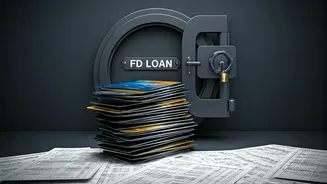FD Loan Basics
Taking a loan against a Fixed Deposit (FD) involves using the money you've saved in your FD as collateral to secure a loan. It's a straightforward process:
you approach your bank or financial institution, and they evaluate your FD. Once approved, the loan amount is typically a percentage of your FD value. The key benefit of this approach is the interest rate, usually lower than what credit cards charge. This makes it a cost-effective method to consolidate high-interest credit card debt. The loan is secured by your FD, meaning the bank has a guarantee of repayment. The FD continues to earn interest, although the interest earned might be offset by the interest paid on the loan. It offers a structured repayment plan compared to the revolving nature of credit card debt. This can lead to better financial discipline. It is also an easier way to improve your credit score.
The Application Process
The process of applying for a loan against your FD is relatively easy. First, you'll need to approach the bank where you hold your FD account. You'll have to fill out an application form, providing details about your FD and the loan amount you require. The bank will then assess your application, verifying the details of your FD. Upon approval, the bank will sanction the loan, setting the terms, including the interest rate and repayment schedule. The loan amount will be credited to your account, which you can then use to clear your credit card dues. Ensure that the loan amount covers your credit card debt plus any associated fees or penalties. Review the terms and conditions carefully, paying attention to the interest rate, repayment tenure, and any prepayment penalties. Repayments are usually made through EMIs, so ensure you budget accordingly to avoid any defaults. A loan against FD can provide a more structured approach to managing debt.
Weighing the Pros
Several advantages make loans against FDs an attractive option for managing credit card debt. First, the interest rates on these loans are generally lower than the rates charged on credit cards, providing significant savings. Secondly, it is a secured loan, meaning you are less likely to be rejected. This offers a more structured repayment plan compared to the revolving debt cycle of credit cards. It helps you to avoid late payment fees and penalties, maintaining a good credit score. It can also serve as a financial discipline tool, encouraging you to manage debt responsibly. You can continue to earn interest on your FD, even while you are repaying the loan. It can be a practical alternative to consider to avoid the cycle of high-interest debt that can be challenging to manage over time.
Considering the Cons
Despite the benefits, there are also some drawbacks. One major consideration is that your FD will be locked until the loan is fully repaid. This means you will not be able to withdraw the money from your FD early. Additionally, while the interest rates are lower than credit card rates, you are still paying interest on the loan. It is important to carefully compare the interest costs over the entire repayment period. Prepayment penalties may apply if you choose to repay the loan early, so familiarize yourself with these terms. Moreover, taking on a loan means taking on another debt obligation. Therefore, you should make sure you can meet the EMI payments without straining your finances. Evaluate if a loan against your FD aligns with your financial strategy and needs before committing. Careful evaluation will help in effective debt management.
Making the Decision
Before deciding, assess your current credit card debt and your FD's value. Calculate the total interest you're paying on your credit cards and compare it to the potential interest rate on the FD loan. Consider your repayment capabilities and choose a loan tenure that aligns with your financial situation. Make a detailed budget to ensure you can comfortably meet the EMI payments without disrupting your finances. Explore different banks and financial institutions to compare interest rates, terms, and conditions. Understand all the fees associated with the loan, including processing fees and any prepayment penalties. Once you have made your decision, ensure you read and completely understand all the terms before signing the loan agreement. With careful planning and informed decision-making, using a loan against your FD can be a smart and beneficial strategy to manage your credit card debt, offering both financial savings and better control over your finances.













